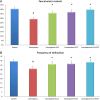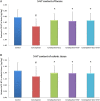The effect and mechanism of electroacupuncture at LI11 and ST37 on constipation in a rat model
- PMID: 26561562
- PMCID: PMC4941155
- DOI: 10.1136/acupmed-2015-010897
The effect and mechanism of electroacupuncture at LI11 and ST37 on constipation in a rat model
Abstract
Background: Electroacupuncture (EA) is used clinically for the treatment of constipation. Serotonin (5-hydroxytryptamine, 5-HT) plays an important role in colonic motility; however it is unknown whether alterations in colonic 5-HT are associated with EA. In this study, the effect and mechanism of EA at acupuncture points LI11 and ST37 were examined using a cold saline-induced rat model of constipation.
Methods: A rat constipation model was induced by cold saline gavage in 24 Sprague-Dawley rats. A further six rats were included as a Control group. The constipated rats were divided into four groups (n=6 each): a Constipation group that remained untreated; a Constipation+LI11 group that received EA at LI11; a Constipation+ST37 groups that received EA at ST37; and a Constipation+LI11+ST37 group that received EA at both LI11 and ST37. After EA treatment, faecal water content, defaecation frequency, and gastrointestinal (GI) transit were measured, as well as the expression of tryptophan hydroxylase (TPH) in colonic tissues (by Western blot analysis) and 5-HT in both faeces and colonic tissues (by ELISA).
Results: All three EA-treated groups demonstrated significant improvements in faecal water content, defaecation frequency and GI transit (p<0.05). In addition, TPH and 5-HT expression were both increased by EA at LI11 and/or ST37 (p<0.05). There were no significant differences between the three EA groups for any outcomes.
Conclusions: EA at LI11 and/or ST37 had a positive effect on objective markers of constipation in a rat model. In addition, EA increased 5-HT and TPH in the colonic tissues.
Keywords: GASTROENTEROLOGY).
Published by the BMJ Publishing Group Limited. For permission to use (where not already granted under a licence) please go to http://www.bmj.com/company/products-services/rights-and-licensing/
Figures




References
-
- Mayo Clinic R, Minnesota. The central nervous system structure and function. 3rd edn Oxford University Press US, 2004.
MeSH terms
Substances
LinkOut - more resources
Full Text Sources
Other Literature Sources
Medical

